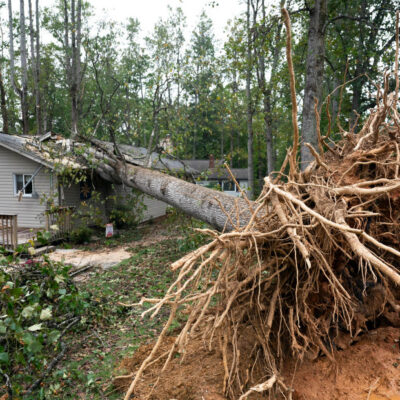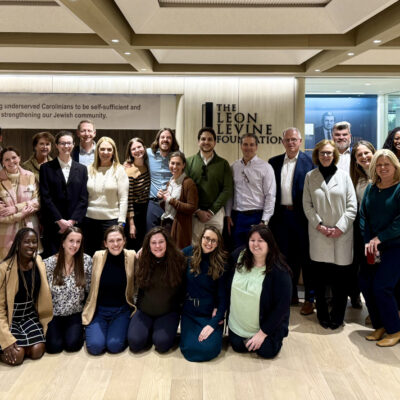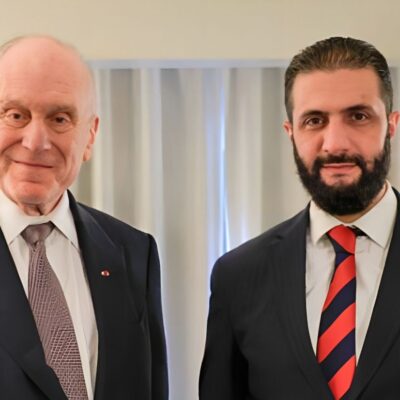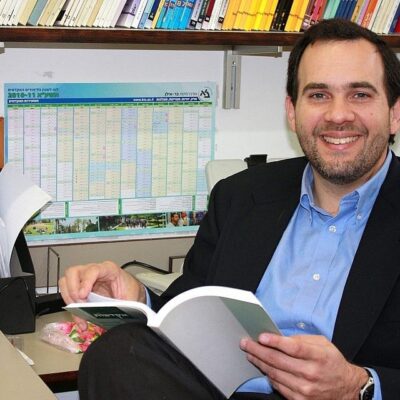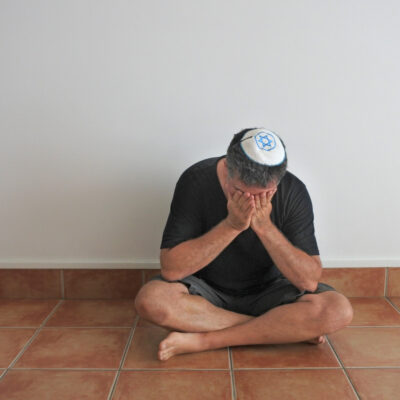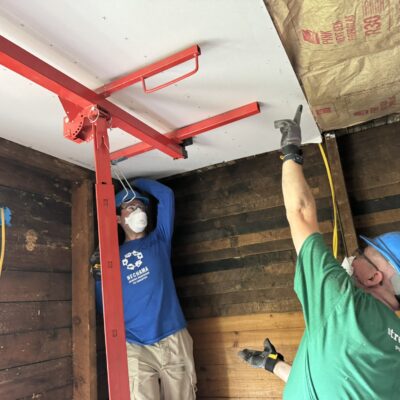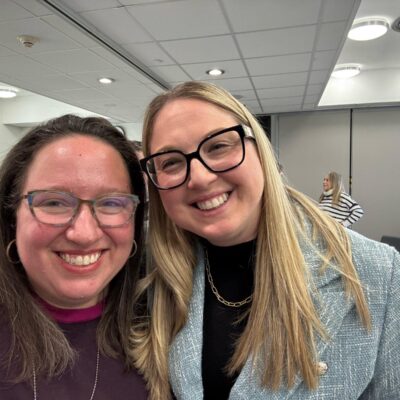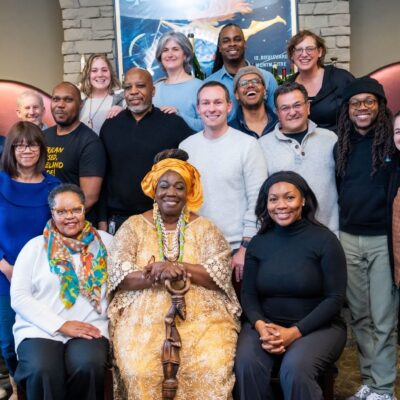Q&A
With $2 billion and 50 years to spend it, Leon Levine Foundation hopes trust (and data) will help it make an impact in the Carolinas
The organization, launched by the founder of Family Dollar Stores, is conducting a demographic study of the Carolina Jewish community to better understand its needs
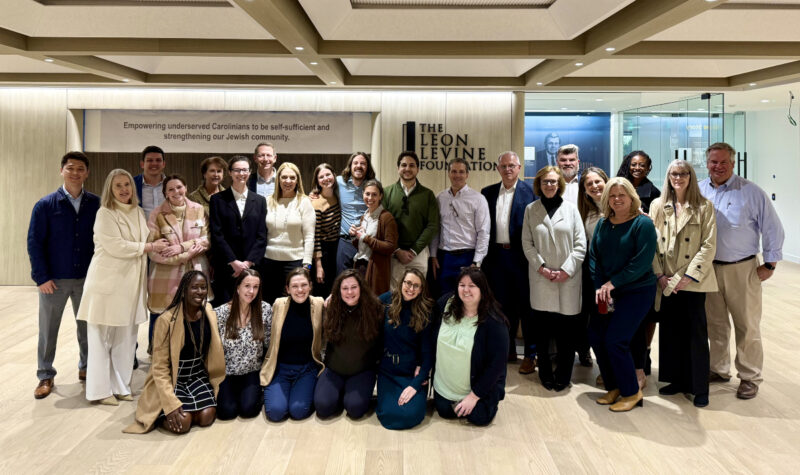
Courtesy/Leon Levine Foundation
The staff of the Leon Levine Foundation at its offices in Charlotte, N.C.
CHARLOTTE, N.C. — This weekend marked the one-year anniversary of Hurricane Helene, which tore through Western North Carolina and surrounding parts of the Southeast, killing more than 250 people and causing nearly $80 billion in damage.
One of the first philanthropic organizations to fund immediate relief work in the wake of the tropical storm was the Leon Levine Foundation, which was created by the eponymous founder of the Family Dollar Stores chain and focuses its efforts on the Carolinas, both the region in general and the Jewish community there.
Beyond its hurricane response work, the past year has been a significant one for the Charlotte, N.C.-based foundation, as its assets surpassed the $2 billion mark and its annual allocations exceeded $100 million, making it the second-largest private foundation in the state and among the 75 largest in the country. Unlike many philanthropic foundations, the Leon Levine Foundation does not plan to exist in perpetuity; over the next 50 years, it will distribute all of its assets and then “sunset.” This is allowing the foundation to issue larger grants than it could if it were looking to maintain its assets indefinitely.
Though its support for Jewish causes represents a small fraction of its overall grants, it is one of the most significant donors to the Jewish communities in North and South Carolina and by far the largest funder of the Jewish community in Charlotte, whose population has grown rapidly over the past 20 years. The foundation was the primary donor to the city’s Shalom Park, a manicured 54-acre Jewish life campus that is home to a Jewish Community Center, Jewish federation, community foundation, two synagogues, a preschool, a school, a library and a day camp, among other Jewish services, including a dedicated multi-car security detail.
To hear more about the foundation’s plans for the next 50 years, as well as its work in Western North Carolina after Hurricane Helene and in the Jewish community post-Oct. 7, eJewishPhilanthropy visited the organization’s headquarters in Charlotte, speaking with its CEO, Thomas “Tom” Lawrence III; its senior vice president, Justin Steinschriber, who previously served as senior program officer of its “Jewish Values” portfolio; and its current “Jewish Values” senior program officer, Jen Rosen.
Judah Ari Gross: Let’s start with the foundation’s recent announcement about its accumulation of more than $2 billion in assets and its plans to “sunset” in 50 years time. Where does that fit into the foundation’s overall vision and mission?
Thomas “Tom” Lawrence III: As you probably know, Leon Levine was the founder of Family Dollar Stores here in Charlotte in 1959 and ran the company as its chairman, founder and CEO until his retirement in 2000. Not a person to retire per se, he started his second career, which was running the Leon Levine Foundation and really spent a lot of time creating the mission statement and the vision and spending time on what the role of the foundation was going to be, how we support those communities and those people who helped Family Dollar become successful in the early days. From that the mission of the foundation was born of empowering underserved Carolinians to be self-sufficient and strengthening our Jewish community. Four primary mission areas: education, healthcare, human services, Jewish values. They represent the fullness of the mission.
Unfortunately, we lost Mr. Levine in April 2023. With his passing, he gave us a tremendous gift, not only of resources to the foundation, which were extraordinarily generous, but also the gift of responsibility to fulfill his mission and entrusting us with his legacy of giving and of philanthropy. So that’s something we take very seriously at the foundation. We think about it constantly, and it directs our decision-making through the lessons that he taught us and the values that he held.
JAG: The decision to sunset after 50 years, was that baked into the foundation from the beginning?
TL: The decision to sundown the foundation has been in place for a while, not from the very beginning, but as the foundation grew in size in the late 2000s-early 2010s, there were a lot of conversations and Mr. Levine created a strategic plan around what the foundation would look like even beyond him. And the idea of a sunset was important from his perspective to not only ensure that the ideas, the vision, the mission that he had in place was fulfilled, but also to create a legacy with urgency and with intentionality around the work.
As we think about “sunset,” the definition is a fixed amount of time during which a foundation has to spend all of its assets, and, at the end, it goes away. The idea was that while we have that 50-year time period, the expenditure of those assets beyond our required 5% per year should be intentional. It should be about the permanency of the impact. And so we prefer the idea of a sunrise — in opposition to a sunset — because it’s the perpetuation of the impact, not of the foundation itself.
JAG: Do you know yet what that will entail? Will it be supporting specific initiatives and programs or building endowments to help develop the long-term health of the organizations that the foundation supports?
TL: Historically, the foundation has spent a significant amount of time and effort with a grant-making strategy that has primarily been through unrestricted multiyear operating funding, and that certainly continues. That’s been a really important component of grant-making with our partners.
Going forward with the growth in assets, the growth in research and development, looking at how we can identify those gaps of need within our mission areas and within our communities and find intentional, strategic, transformational initiatives that can really create long-term and permanent impact. We have the ability to create permanency within those concepts.
JAG: For areas like health care, does that mean that you are looking more at megatrends in the region and building up infrastructure for the long term — helping build a new community hospital in an area that’s projected to see population growth, for instance — or is your window more immediate and creating that impact today?
TL: A little bit of both. We continue the unrestricted operating grants that support the latter. The growth and the more strategic, systemic grant-making is more for permanent impact for the community.
And I would say the twist for us is that looking at those large trends is important, but identifying which ones can philanthropy particularly have a unique and positive impact. So your example of healthcare is a good one. A focus area for us might be behavioral and mental health challenges, which are very significant across our region and across the country. The ability for philanthropy to play a significant role in helping to identify, pilot, scale new initiatives that can really create a unique impact for underserved patients across the Carolinas.
Justin Steinschriber: I would just add on that one of the things that this gift that Mr. Levine has given us allows us to do is maintain the relationships we’ve had for many years.
As an example, for most Jewish organizations across the Carolinas, we’ve been a strong and consistent partner for many years. We plan on continuing that, but it also gives us the ability to look towards the future and help imagine what that looks like with community members, with partners, and start working towards that and being able to make some big bold bets on some things that we think might work towards that.
JAG: Yes, I’d be happy to hear where there are areas for growth that the foundation sees in the Carolina Jewish community. What are you seeing already in terms of population growth and demographic shifts?
Jen Rosen: We’ve commissioned in partnership with the Jewish Federations of North America to do a demographic study across both North and South Carolina, because we have a sense [of the growth] from national trends and from the rough numbers that are out there, but in order to craft a strategy that’s going to be the most impactful we want to actually understand who these folks are, what the needs are, how people connect now, how long they’ve been in their city. So we’re hoping to have those initial findings in the fall.
Taking a step back for a second, the Jewish communities in the Carolinas have been on a growth trajectory for years, and that growth, fortunately, has been layered on top of a really dynamic Jewish infrastructure, which we’ve gotten to play a role in.
That ongoing demographic growth, coupled with the increased needs post-Oct. 7 in terms of interest, but also in terms of just general needs and education, we think that there’s really a great opportunity to make the Jewish community in the Carolinas even stronger. Our North Star is that Jewish Carolinians find Jewish values, education, tradition and community compelling and accessible. We believe — this is part of what we’re trying to establish a baseline for — that Jewish life in the Carolinas can have some of the highest engagement levels in the country, and that’s what we’re privileged to be trying to play a role in making happen. And a more engaged Jewish community fosters greater meaning, belonging, contributions to civic society, and also helps to further drive the region’s growth.
We’re working closely with national funders and identifying opportunities to pilot and try things out here in the Carolinas, and we are also leaning on other philanthropists, foundations, and other regions of the country so we can learn from their strategies and approaches too.
But as we kind of dig into this piece, there are three primary buckets that we think that we will be able to maximize our strategic impact, and this is across both states. No. 1 is to grow proven identity-building Jewish educational experiences in kids through young adults. That’s primarily through immersive experiences, but also Jewish experiences that people experience in regular ways that add meaning to their lives. No. 2 is helping to seed additional Jewish hubs and infrastructures in areas where we’re seeing the most population growth. So that will certainly be informed by the demographic study. And No. 3 is really about further developing strong Jewish leaders, professionals and lay, and allies who are equipped to navigate both Jewish and civic spaces and help to elevate the presence of our Jewish community in the Carolinas.
JAG: Is the demographic study already underway? Do you have a sense of where things are?
JS: What’s been interesting is we know the demographics of the states, and we know that North and South Carolina are growing rapidly, and we know a rough estimate of the Jewish population within those, and we’re making assumptions that it has stayed consistent as a percentage basis. But one of the challenges we’ve always run into is almost every community has done one demographic study sometime in the last 25 years. And so the data you’re working with is often really out of date, and you’re often looking at anecdotes or only the stories of people who show up. So a critical aspect of this work is saying, “We know things have changed, we just don’t know how.” We know which cities are growing, we know which cities are not, but that’s not necessarily gonna equate to what Jewish populations look like. And so we’re hoping that this will give us some answers to those questions.
JAG: Regarding the Jewish educational experiences that you mentioned, do you know where you’re looking to support that?
JR: We’re already involved in a lot of different kinds of Jewish immersive experiences from Jewish summer camps throughout the Southeast. Birthright Israel is another. And then Jewish day camps and Jewish day schools, which we’ve been supporting for years. So I think this is really about continuing to support those key players, but also dreaming about what it would mean to dramatically increase our reach.
I think some of the early places we’re exploring is Jewish summer camp: How do we significantly grow the number of Jewish kids from the Carolinas attending Jewish summer camp? That’s one of the ideas we’re playing with.
JAG: Would that be on the side of scholarships or of building up the camps to make them more attractive?
JR: We’re working with the Foundation for Jewish Camp as a partner, and we have been partnering with the Jewish federations throughout the states too.
We’re doing a small gathering in November, where we’re going to bring together some thought leaders from the Jewish and non-Jewish camping world and start thinking outside of the box at how might we dramatically increase the number of kids that are having that kind of Jewish experience.
JS: “We don’t know yet” is the answer to that. One of the really important things that ties back to Mr. Levine is that he was a businessman first, and as a philanthropist, he was also a businessman.
So as he built this foundation and the priorities and the values that we have, one of those lenses was always how do we make even the nonprofits we’re partnering with viable economically? How do we make sure that they are running themselves as businesses with a sustainability mindset, with the right board, with the right leadership. And that’s always been a lens we’ve taken, and so, as we then look to this next chapter, one of the things that we are thinking about is not just how do we expand this program, but let’s take a step back and say, “Is this built on the correct foundation to begin with?” And let’s have conversations to see what alternatives might look like as we go forward.
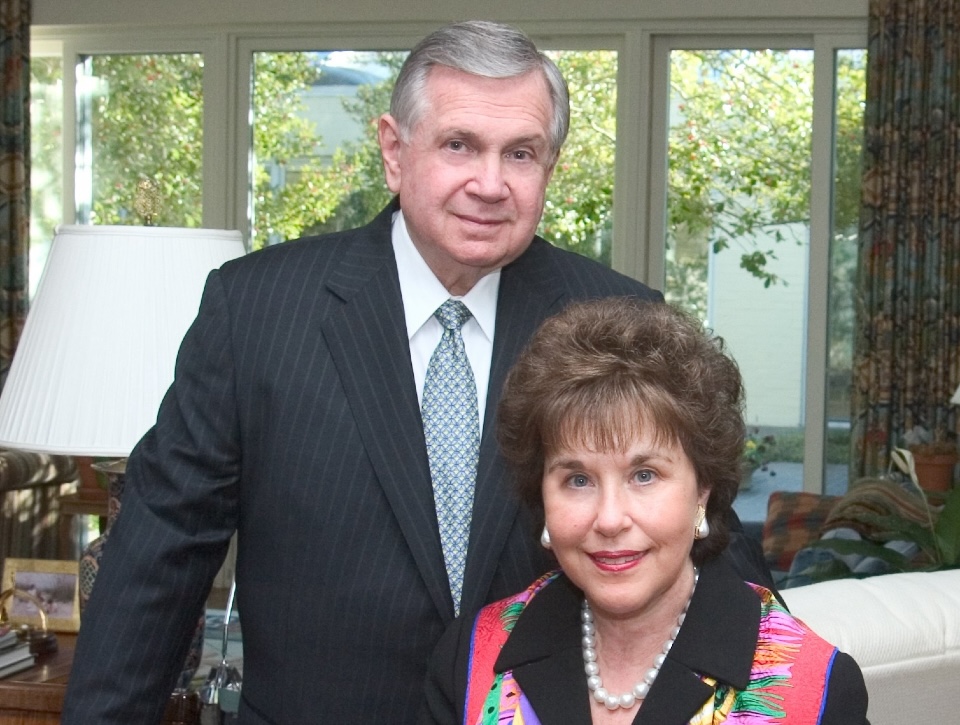
JAG: Is that something that the foundation would look to play an active role in? To get involved in the governance of partners or potential partners or are you more looking at the field and seeing who is already strong on that level that the foundation can support?
JS: The primary, historical approach has been that we’re doing it through the lens of an evaluation. We’re looking at how the organization is structured, looking for the markings and the hallmarks of really strong, well-run organizations. We’re looking for things like strategic plans and succession plans and all those fun things.
But as you might imagine, we also view this from the lens of a partnership. And so the question then becomes, when someone wants to partner with us, now let’s have a conversation about the best pathway to success. It’s not that we’re walking in and telling you how to change your organization.
Being geographically focused, there isn’t a free market of potential partners, so it actually lends itself to partnership much more than certain communities that feel more competitive, in which you can say I’m walking away from you because I’m going over here. It’s given us a really strong lens of partnership, which has been really supported by Mr. and Mrs. Levine in their lifetimes.
As you think about the concept of Shalom Park — which if you haven’t been, I hope you go — it was one of the first places in the country to house all of the major Jewish institutions of a city in one space. By its nature, it requires a level of cooperation and partnership that is very uncommon from what we can see around us and has really allowed Charlotte to have some special elements to it. It’s brought a community together in ways that I know didn’t exist prior to Shalom Park.
There are plenty of people who can tell stories of growing up in this town who said, “I went to one temple, I didn’t know the people at the other one.” That’s not the case anymore. The centralized hubs of the JCC and schools create this sense of a community that is truly in this together and building together all the way from donors to volunteers to participants and on down the line. One of the really beautiful things about the communities across the Carolinas is that they all take that mindset of how do we do this together, not how do we do this in competition with one another.
JAG: In terms of the three areas that you named as your core areas under the foundation’s “Jewish Values” portfolio, are those long-running priorities or are they in response to the past years?
JS: None of them are new to us. They have been part of our approach for many, many years, along with many other things. As Tom mentioned, with the “sunrise” opportunity, it gives us a chance to do two things simultaneously. We are not walking away from unrestricted operating support for a lot of partners across the community. But with the additional resources, we had the chance to be very intentional with the new investments we want to make.
And so the process we’ve done over the last couple of years — across the whole organization, not just “Jewish Values” — has been to ask, “What are those places where philanthropy can have an outsized impact, rooted in research and evaluation?”
I’ll also go on a two-minute tangent. Two years ago, we had no research and evaluation team. We obviously looked at outcomes and data and things of like that within our grant evaluation process, but we have now built a four-person research and evaluation team to help drive some of these processes towards understanding where we can have the greatest impact.
JAG: Tell me more about the decision to create a research and evaluation team. To go on a further tangent, there’s a debate within the philanthropic world about trust-based philanthropy versus a far more controlled model. Where does the foundation fit into that?
JS: If you’ll allow me, I’ll say we’re in both groups. A really critical piece is that we have 400-plus partners for many years, almost exclusively receiving multiyear unrestricted operating funding. That’s pretty trust-based.
But that trust was based on something. It was based on them being strong, well-run organizations that could demonstrate the impact on the community
We want to make sure that we’re placing those bets in a reasonable, thoughtful, intentional way. So it’s great to be bold and take bold action, but boldness without intentionality or thoughtfulness doesn’t align with what we would like to do. So the decision to bring on the research and evaluation team was tied to that. That’s not to say that the numbers will dictate at every single pass. We obviously still have a human staff here, too.
TL: The concept of trust has been really important in Leon Levine’s philanthropy from the beginning, and it’s something that we really think hard about going forward today, as Justin indicated. There’s a real intentionality around creating those partnerships because with partnership comes trust.
From our standpoint, we don’t have all the answers to the question. We rely on our partners to help us not only identify what those needs are, but to craft the right intervention for them or the right grant to be most effective. And so while we have a research team that can help us understand the landscape for our grant-making, it also helps our partners understand where we can collectively be most impactful.
JAG: To shift topics, how has Hurricane Helene affected the foundation in terms of its partners or additional requests that came in as a result of the damage and the increased needs?
TL: We have dozens of long-term partners in Western North Carolina and in the state of South Carolina that were dramatically affected. Our board took immediate action in the days following the hurricane, so we implemented a significant series of grants in support of the immediate needs within the region. A $5 million pool was created. Our mission teams worked with organizations that we knew and could be in touch with. That was important to happen quickly, along with so many other foundations in the region. The outpouring was significant.
As we now come to nearly a year later, we continue to hear needs from partners, we continue to work with them. It’s part of our grant-making process, and so as we work with our partners in those regions, we talk to them about what those needs are.
JAG: Are there any specific projects that have come out as a result or are coming out as part of reconstruction efforts?
TL: A lot of our focus was on immediate need and building that safety net, which, as you know, had been severely degraded or eliminated in a lot of ways. There have been several new initiatives or facilities that are coming out. The Manna Food Bank [in Asheville] was completely washed away in the flood, and it is now in the process of being rebuilt. They’ve been an important partner for us for a long time, and we’ve obviously been in touch with them.
JR: So much of that work was relief-focused, and one piece that I do think is a good example of your question is that we did play a role in bringing Nechama, the Jewish disaster relief group, to Western North Carolina. They’re still there. That was really a privilege to get to do.
JAG: Can you speak any more about how, or if, the foundation’s Jewish grant-making has changed post-Oct. 7, particularly as such a regionally focused organization?
JS: Throughout our history and still today, two priorities of the foundation have been supporting the U.S.-Israel relationship and supporting Israel as a free, democratic, Jewish state. And obviously, the world is very complicated right now, and there are a lot of things going on there. And while we have certain grants that relate to those two areas, I think the vast majority of how we’re approaching that continues to relate back to what effects does that have on people living in North and South Carolina, the Jewish communities across this two-state region.
As we have approached our work in the last two years, it’s really been with that frame of mind of, “How can we continue to be supportive of the local Carolinian Jewish communities, as the world around them keeps evolving?”
JR: We have seen an increase in our giving for Israel education and Israel engagement. But post-Oct. 7, and I have alluded to this, with “the Surge,” our partners are seeing double the number of students than they were seeing before and just really people showing up in new ways. We’ll learn more from the demographic study, but there seems to have been sustained impact here.

 Add EJP on Google
Add EJP on Google